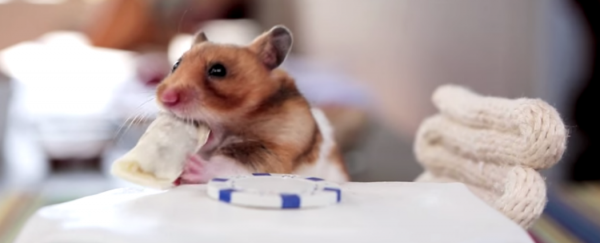Remember this?

If this is your first acquaintance with Tiny Hamsters Eating Tiny Burritos, you're welcome. Beady-eyed rodents stuffing meticulously constructed parcels of chicken, capsicum, coriander and salsa into their faces is what life is all about.
But have you ever wondered how a hamster, which only weighs about 120 to 160 grams, could mash so much food into its face, its head can actually triple in size? And instead of all of that stored food becoming a soggy, mushy mess of crumbs and saliva inside those cheek pouches, when it comes time to retrieve everything, it looks brand new! What's going on here?
Fortunately, researchers at the BBC asked themselves the same question, and recruited a golden hamster (Mesocricetus auratus) and an X-ray machine to find out:

As the video above reveals, those cheek pouches aren't just in the hamster's cheeks - they extend all the way down TO ITS HIPS, allowing it to carry an entire bowl full of treats around in its flanks. And because hamster cheek pouches don't contain saliva glands, everything is kept fresh and dry during the transit back to its artificial burrow. Imagine if we could do that every time we go to a business meeting that's overflowing with pastries.
Native to the arid landscapes of Syria and Turkey, golden hamsters evolved their cheek pouches so they could take full advantage of food wherever it happens to turn up. It's not always practical to eat it right then and there on the spot, so they stuff it inside and take it back to their burrows for later. They're so good at this, that when Jewish biologist Israel Aharoni travelled to Turkey during the 1930s to study the species or the first time, he said the golden hamster's name in the local Arabic dialect, أبو جراب, roughly translates to "mister saddlebags". Aww.
Golden hamsters - also known as Syrian hamsters - are the most common species of hamster in the world, but they're scarcely spotted in the wild. Estimates tentatively put their wild population at fewer than 2,500 mature individuals, which has led the ICUN to classify them as 'vulnerable' to extinction.
Source: The BBC
